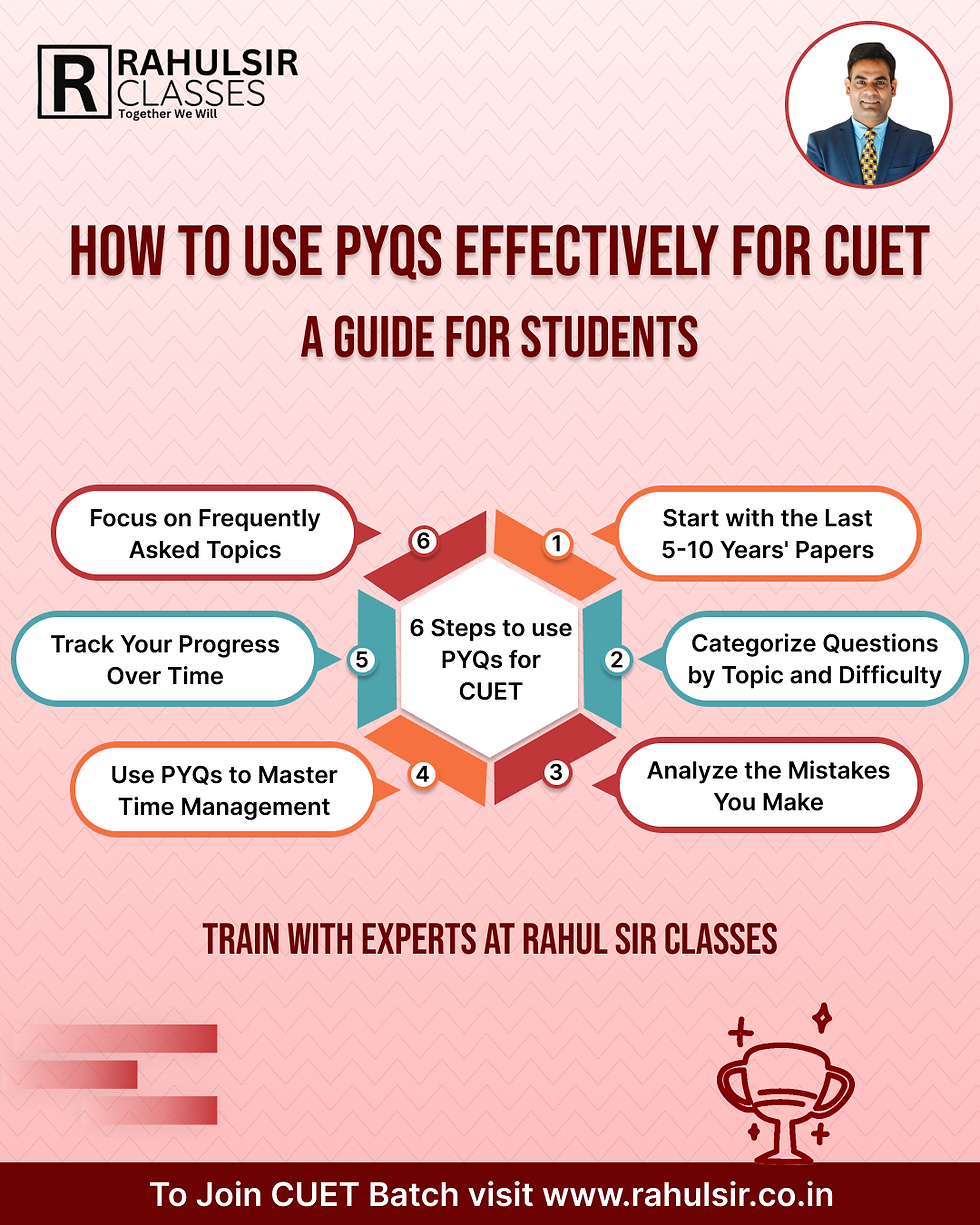How to Use PYQs Effectively for CUET: A Guide for Students
- RAHUL SINGH

- May 18
- 4 min read
The Common University Entrance Test (CUET) is one of the most competitive exams for students aiming to get into top universities in India. As the competition intensifies, having a smart study strategy becomes crucial for success. One of the most effective tools for preparing for CUET is practicing Previous Year Questions (PYQs). These questions give students insights into the exam's structure, difficulty level, and the type of questions that frequently appear. In this blog, we will explore how you can use PYQs effectively to boost your CUET preparation.

1. Understand the Exam Pattern and Marking Scheme
Before diving into PYQs, it’s important to have a clear understanding of the CUET exam pattern and marking scheme. CUET consists of multiple sections, and each section tests different skills. By going through the previous year's questions, you can familiarize yourself with how each section is structured. This helps in understanding which types of questions appear most often, what topics are given more importance, and the marking scheme.
Tip: At Rahul Sir Classes, we guide students on how to analyze the exam pattern based on PYQs and build a focused study plan that aligns with the CUET exam structure.
2. Start with the Last 5-10 Years' Papers
The most effective way to start using PYQs is by solving the papers from the last 5-10 years. This will give you an overview of the exam's evolution and allow you to identify recurring questions and patterns. Make sure to solve the papers under timed conditions to get an authentic exam experience.
Tip: Begin by solving one paper every week, gradually increasing the frequency as the exam date approaches. This will help you stay on track and assess your progress.
3. Categorize Questions by Topic and Difficulty
As you solve the PYQs, it’s helpful to categorize them based on topics and difficulty levels. This will allow you to focus on the areas where you need improvement. For example, if you consistently find questions from a specific topic challenging, allocate more time to study that topic.
Tip: Rahul Sir Classes provides customized worksheets that help students categorize PYQs by subject and difficulty level, ensuring that your practice is more focused and efficient.
4. Analyze the Mistakes You Make
One of the most valuable aspects of solving PYQs is the opportunity to learn from your mistakes. After solving a paper, carefully review your answers, especially the ones you got wrong. Identify why you made those mistakes—was it a lack of understanding of the concept, a time management issue, or a careless mistake?
Tip: Maintain a notebook where you jot down the mistakes and revisit them regularly. This helps you track your progress and ensures that you do not repeat the same errors.
5. Use PYQs to Master Time Management
Time management is a critical factor in CUET success. By practicing PYQs, you can work on your speed and learn how to manage time efficiently during the exam. Try to solve a paper within the allocated time frame and identify sections where you tend to spend too much time.
Tip: Rahul Sir Classes focuses on time management techniques, teaching students how to balance speed and accuracy by using PYQs in timed practice sessions.
6. Track Your Progress Over Time
As you continue to solve more PYQs, it’s essential to track your progress. Are you getting more questions right than before? Are you managing your time better? Use this data to adjust your study plan and improve on your weak areas.
Tip: Rahul Sir Classes provides regular assessments and feedback, helping you monitor your progress and make necessary adjustments to your preparation strategy.
7. Focus on Frequently Asked Topics
Certain topics tend to appear more frequently in CUET exams than others. PYQs help you identify these topics and prioritize them in your study plan. By mastering these frequently asked topics, you can ensure that you score well in these areas and gain an edge over other candidates.
Tip: Pay extra attention to these frequently asked topics in your PYQ practice, as they are often key to scoring high marks.
8. Simulate Full-Length Mock Tests
Once you have solved a sufficient number of individual PYQs, it’s time to simulate full-length mock tests. These mock tests should be taken under exam-like conditions, with strict time limits and minimal distractions. This will help you build endurance and improve your ability to stay focused during the actual exam.
Tip: At Rahul Sir Classes, we offer comprehensive mock tests that closely replicate the CUET exam environment, helping you practice for the real exam.
9. Review the PYQ Solutions Carefully
After solving each PYQ, go through the solutions carefully. Don’t just focus on the correct answers, but also understand the reasoning behind them. This will deepen your understanding of the concepts and improve your problem-solving skills.
Tip: Rahul Sir Classes provides detailed explanations for every PYQ, ensuring that you understand not just the answer but the approach to solving each question.
Conclusion
PYQs are one of the most powerful tools for CUET preparation. By incorporating them into your study routine, you can familiarize yourself with the exam format, improve your time management, and identify key topics that require more attention. Regular practice of PYQs will help you stay ahead in the competition and ensure a higher chance of success in the CUET exam.
At Rahul Sir Classes, we offer personalized coaching and comprehensive resources to help you make the most of your PYQ practice. Start your preparation today and take the first step towards becoming a CUET topper!
Ready to start mastering your CUET preparation? Join Rahul Sir Classes today and get access to tailored study materials, expert guidance, and continuous support throughout your journey. Contact us now to book your free consultation and kickstart your success!



Comments